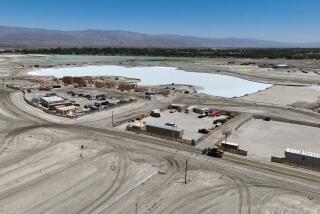Upgrade in Avalon
- Share via
AVALON, SANTA CATALINA ISLAND — Trying to restore its luster as a tourist destination, this cozy harbor town is undergoing its most ambitious overhaul since chewing gum magnate William Wrigley Jr. built the town’s signature feature in 1929: Avalon Casino.
More than half a dozen projects are underway or planned in the 2-square-mile community, including a museum, hotel, spa, aquatic facility, chapel and wine-tasting room. Renovations are planned for the island’s golf course, and the oceanfront beach club is expanding.
“Catalina is becoming a new old place,” said Geoffrey Rusack, whose wife, Alison Wrigley Rusack, is a great-granddaughter of Wrigley Jr.
The idea is to a revive tourist trade that flourished in the last century. In the 1920s, Wrigley Jr. brought steamships, hotels and a landmark “casino” building to Avalon, transforming the island into a storied getaway for movie stars and Los Angeles’ early power brokers. Over the decades, visitors were drawn by its quaint oceanfront Victorian cottages and a beach edged with a curved, cafe-lined promenade.
In the 1960s, celebrities, tourists and developers began gravitating toward newer resorts blossoming on the mainland: Disneyland, Palm Springs, Lake Arrowhead.
The most eagerly awaited of the new projects is the museum, on Metropole Street in the center of town. The $6-million Ada Blanche Wrigley Schreiner Building of the Catalina Island Museum will feature 11,000 square feet of floor space, with a gallery devoted to traveling art exhibits that museum and community leaders hope will be strong enough to entice visitors from the mainland.
“This institution is going to change Avalon forever,” museum Executive Director Michael De Marshe said, raising his voice to be heard over the clamor of hammers and saws.
The structure also will house the collection from the existing museum, which is on the first floor of the casino building. That collection includes Catalina landscape paintings, pottery, vintage photographs, archival documents and Native American artifacts dating back thousands of years.
Elsewhere, the Santa Catalina Island Co., which owns all of the developable property in town, is constructing a spa and plans to build an aquatic facility with three freshwater swimming pools, a community center and a hotel with more than 100 rooms. It is also plans to build more than 120 homes that will sell for about $1 million.
Separately, the Rusacks have planted the island’s first vineyard 17 miles west of Avalon, and plan to add a wine-tasting room and a chapel with panoramic views.
The museum, scheduled to open in 2015, has already altered centers of influence on the island. Some of its largest financial contributors were formerly allied with the nonprofit Catalina Island Conservancy, which manages the island’s wild lands. Those contributors left the conservancy over disagreements with the executive director’s management style.
The conservancy also has development plans. The Catherine Hotel, an aging structure once known for serving the coldest beer in Avalon, will be torn down and replaced with “The Trailhead,” a nexus of nature exhibits, classrooms, accommodations and a gift shop where tourists can buy tickets for Jeep tours of the island’s interior.
About 88% of the 75-square-mile island is owned by the conservancy. The Santa Catalina Island Co. owns about 11% of the land mass, and about 1% is owned by private individuals and the city of Avalon.
The building boom follows an uptick in tourism over the last four years attributed, in part, to new attractions including a zip line and novel museum exhibits that had little to do with the island’s heritage.
For decades, the museum focused on the Avalon of seven decades ago. That changed in 2010 with the appointment of De Marshe, who had been the founding director of three museums, including the Cafesjian Center for the Arts in Yerevan, Armenia.
Since then, the museum has attracted record crowds with exhibits featuring the Beatles, Marilyn Monroe and the Chicago Cubs. Its membership has grown from 300 to nearly 2,000.
Not everyone in the community of 4,000 embraces the change, however. Avalon City Councilman Ralph Morrow said the improvements “are making a lot of people nervous. All of a sudden -- boom! -- we’ve got workmen going 500 miles an hour tearing down old structures and building new ones.”
Some residents also prefer the status quo at the museum, fearful it will move away from its devotion to the island’s heritage.
De Marshe says they shouldn’t worry. “We’re not turning our backs on Catalina history -- far from it,” he said. “But if critics didn’t like the Beatles and Marilyn, they’re going to have serious problems with Picasso.”
--
More to Read
Sign up for The Wild
We’ll help you find the best places to hike, bike and run, as well as the perfect silent spots for meditation and yoga.
You may occasionally receive promotional content from the Los Angeles Times.







